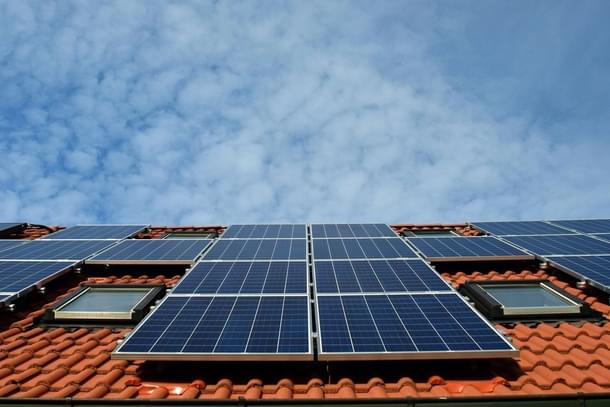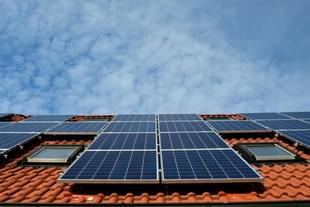Infrastructure
Shelter And Power: How India Plans To Go Big On Rooftop Solar Plants
Amit Mishra
Feb 25, 2022, 03:44 PM | Updated 03:44 PM IST
Save & read from anywhere!
Bookmark stories for easy access on any device or the Swarajya app.


The Ministry of New and Renewable Energy (MNRE) on 2 February issued a simplified procedure to install rooftop solar plants, for residential consumers. The new rules have simplified the Grid-connected Roof Top Scheme.
As per the new policy, it will not be necessary for any household to get the rooftop installed only by one of the listed vendors. The households have the option to install the rooftop solar plant by themselves or through any vendor of their choice.
What is Rooftop Solar Power?
It is a photovoltaic system that has its electricity-generating solar panels mounted on the rooftop of any residential, commercial, institutional and industrial building.
The Solar PV modules/Solar Panels convert solar energy directly into DC (direct current) electrical energy. The DC power generated from the solar panel is converted to AC power using power conditioning unit/Inverter.
PV modules are available in different technologies such as crystalline silicon, thin film silicon, Copper Indium Gallium Selenide (CIGS), Cadmium Telluride (CdTe), HIT, etc. Crystalline Silicon Solar PV panels are most commonly used in solar rooftop systems. Multiple panels are connected together to form arrays as per the desired capacity of the system.
Types of Rooftop Solar (RTS) System
The first one is an RTS with a storage facility. The system which is also known as Stand-alone system has a battery as a storage facility. The solar electricity is stored in the battery and can be utilised during night also. These are used in places with no grid electricity.
Grid Connected Rooftop Solar System (also known as grid-tied systems), is the second variant. These systems generate power during the day time which is utilised fully by powering captive loads and feed excess power to the grid as long as the grid is available. In case, where solar power is not sufficient due to cloud cover etc., the captive loads are served by drawing power from the grid.
The excess power fed to the grid depends on the capacity of the system installed and the regulatory framework. A grid-connected system is designed to automatically shut down if it detects anomalies in grid parameters such as voltage, frequency, change of frequency, etc.
Grid-Connected Rooftop Solar Systems
It is a system installed mainly on the roofs of buildings and includes installations on open contiguous land within the area of premises wherein valid and live electricity connection has been provided by the concerned Distribution utilities/companies (DISCOMs).
Typically, 1 kWp grid-connected RTS plants require about 10 sq. metres of shadow-free area. However, actual area requirements may vary depending on the efficiency of the solar module, and their placement etc. The average cost of such a system is about Rs 80 per watt or Rs 8 crore per Mega-Watt peak (MWp) capacity.
On a clear sunny day, 1 kWp RTS plant can generate 4 to 5.5 units in a day. However, the daily energy generation from the RTS is dependent on the temperature and solar irradiance among other parameters and these may not be the same every day.
The grid-connected systems from 1 kilo-Watt peak (kWp) upto 500 kWp or in combination can be installed at the roofs. The solar power generated can then be used either for captive consumption on the premises or can be fed into the grid and be adjusted in the electricity bill. Net-metering regulations notified by respective State Electricity Regulatory Commissions (SERCs) provide a legal framework for such adjustment.
Grid-connected systems are attractive in many ways. They let consumers meet part of their load from renewable solar energy which leads to savings on electricity bills. Consumers can monetise their rooftops and sell the excess to the DISCOMs.
These plants are also useful in tackling daytime peak load as solar generation profile matches such peak loads during the day.
Such systems have a low gestation period. They do not require any additional transmission and distribution (T&D) lines. These plants help DISCOMs in reducing T&D losses as power consumption and generation are co-located. These systems provide for long term energy and ecological security by way of reduction in carbon emission.
However, it does pose some challenges to DISCOMs. They may lose a high-paying consumer; it may not be economical for them to purchase power from the consumer at the prescribed rate; and they may need to incur additional expenditure on infrastructure to accommodate the renewable solar energy (RE) sold to them by the consumer.
The potential
India is endowed with vast solar energy potential. About 5,000 trillion kilowatt hour (kWh) per year energy is incident over India’s land area with most parts receiving 3-5 kWh per sq. metres per day. Based upon the availability of land and solar radiation, the potential of solar power in the country has been assessed to be around 750 GWp.
National Institute of Solar Energy (NISE), an autonomous institute under MNRE has estimated a potential of 43 GW for Grid Connected RTS in the country. A study conducted by The Energy and Resources Institute (TERI) has estimated a potential of 124 GWp grid-connected rooftop plants.
The ambition
As a part of Intended Nationally Determined Contributions (INDCs) under the Paris Accord on Climate Change, India has committed to increase the share of installed capacity of electric power from non-fossil-fuel sources to 40 per cent by 2030. The Government has set a target to install 175 GW of renewable energy capacity in the country by the year 2022. This includes 100 GW from solar, 60 GW from wind, 10 GW from biomass and 5 GW from small hydro power.
Solar energy is one of the main sources that will be put to use to accomplish the target of 40 per cent of electric power from non-fossil-fuel. The Government of India has set the target of achieving 100 GW of solar power capacity in the country by the year 2022 of which 40 GW is to be achieved from rooftop solar.
The Central Government, on 30 December 2015, approved a program ‘Grid Connected Rooftop and Small Solar Power Plants Programme’ for installation of 4200 MW RTS plants in the country by year 2019-20, of which 2100 MW was through Central Financial Assistance (CFA) and balance 2100 MW was without CFA.
The Government on 19 February 2019 sanctioned the Phase-II of the programme for achieving cumulative capacity of 40 GW RTS plants by 2022.
How is Phase II designed?
The Ministry of New and Renewable Energy, Government of India is currently implementing Phase II of Grid-connected Rooftop Solar Scheme.
The programme aims to create additional RTS capacity of 38 GW in the country by 31 March 2022, out of which a capacity of 4 GW is targeted in residential sector with CFA and 34 GW in other sectors (i.e., Social, Government, educational, PSUs, Statutory/Autonomous bodies, Private Commercial, Industrial Sectors etc.) by suitably incentivising DISCOMs.
For individual households, subsidy upto 40 per cent of the benchmark cost is provided for RTS plants upto 3 kW capacity and 20 per cent for RTS plants of capacity beyond 3 kW and up to 10 kW.
For Group Housing Societies/Residential Welfare Associations (GHS/RWA), the subsidy is limited to 20 per cent of the benchmark cost for RTS plants of up to 500 kW used for supply of power to common facilities.
The Programmes will have substantial environmental impact in terms of savings of CO2 emission. Considering average energy generation of 1.5 million units per MW, it is expected that addition of 38 GW solar rooftop plants under Phase-II by year 2022 will result in CO2 emission reduction of about 45.6 tonnes per year.
The programme has directed employment potential. Besides increasing self-employment, it is likely to generate employment opportunities equivalent to 9.39 lakh job years for skilled and unskilled workers for addition of 38GW capacity under Phase-II of the scheme by the year 2022.
The Government has developed an online platform ‘SPIN’ for expediting project approval, report submission and monitoring progress of implementation of RTS projects.
What is Net-metering?
All solar PV systems generate power only during daytime when the sun is out. In net metered systems, the generated power is utilised for self-consumption, and excess power is exported to the grid as long as the grid is available. In case, where solar power is not sufficient due to cloud cover etc., power is drawn from the grid to power the loads. A bi-directional or net meter records the energy flow in both the directions and at the end of billing period net energy used is calculated. The beneficiary has to pay for only the net energy used.
This is in contrast to the gross metering in which the power generated from the Rooftop Solar plant is only fed to the grid. The system owner gets paid by the DISCOM for such exported power at a pre-decided tariff.
The Union Ministry of Power has issued the much-awaited amendment to the Electricity (Rights of Consumers) Rules, 2020 concerning net metering for rooftop solar installations.
The new rules permit net metering to the consumer for loads up to 500 kilowatts (kW) or up to the sanctioned load, whichever is lower and gross metering for loads over 500 kW.
RTS in MSMEs
Rooftop Solar offers an excellent value proposition to Micro, Small and Medium Enterprises (MSMEs) by significantly bringing down the cost of electricity consumption.
A large amount (average Rs 8 and higher per unit) is being paid by the MSMEs for power consumption, which contributes to up to one fifth of overall production costs. Considering the rates of solar power from large utility power plants have come down to a record Rs 1.99/kWh, MSMEs must leverage this opportunity to bring down their energy expenses.
MSMEs need low-cost power to optimize their production costs, recoup losses due to COVID and remain competitive both in national and international markets.
With a view to addressing the issues on the debt side and to give a fillip to the sector, the State Bank of India (SBI) has availed a $625 million line of credit from World Bank specifically, for financing RTS projects across the country through its identified branches. The MSME sector, through SBI’s current rooftop solar (RTS) lending portfolio can leverage concessional debt and fulfil India’s ambitious target for large scale implementation of rooftop solar.
Amit Mishra is Staff Writer at Swarajya.





